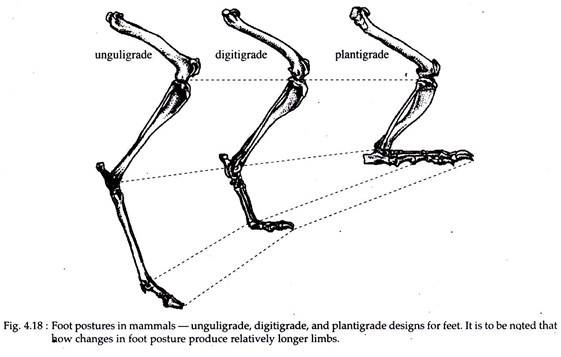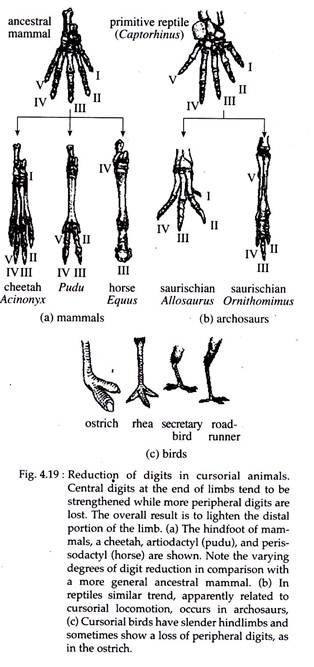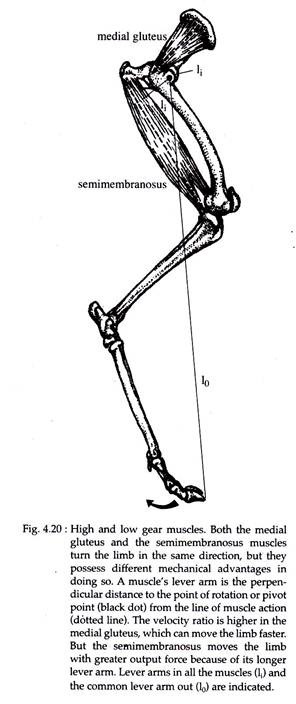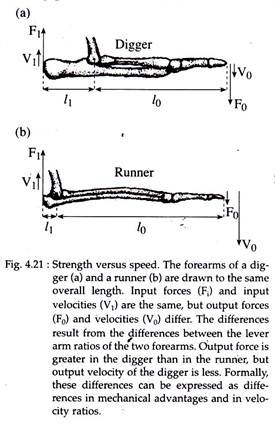Zoology Notes on Cursorial Adaptation :- 1. Introduction to Cursorial Adaptation 2. Essential Features of an Animal to be Cursorial 3. Structural Modifications 4. Mental Precocity 5. Examples.
Introduction to Cursorial Adaptation:
Animals are in need of two prime requisites food and safety. These two factors seem to be of much competitive nature in the open earth surface where one runs after the prey, and prey move speedily so as to escape from the predators.
Although these animals are a minority in the animal kingdom, nevertheless they are of prime importance, as the evolutions of remotely related types have given rise to some remarkable instances of convergent evolution.
The basic feature of this adaptation is to acquire speed. Hence it is also called as speed adaptation. Cursorial adaptation may be defined as the adjustment of animals with the open environment of earth surface (i.e., terrestrial), correlated directly with the adaptation of speed for both prey and predator.
Essential Features of an Animal to be Cursorial:
ADVERTISEMENTS:
In a perfectly cursorial animal inertia of the body must be well regulated to attain speed. Total control over the movements of different parts of the limb and other oscillating body parts to be attained. During locomotion, most of the body parts should be detached from the ground to minimise friction. Navigation of directions should be maintained perfectly during running with the help of well-developed sense organs.
Structural Modifications to Cursorial Adaptation:
Body Contour:
For swift passage through the air with a minimum resistance, the body becomes spindle shaped. The streamlined body has compressed thorax and flattened ribs. The body with well-extended head and neck, backwardly thrown ears and tense muscles represent the most suitable modification for fast moving.
Modifications for Speed Attainment:
ADVERTISEMENTS:
(a) Loss of General Utility:
i. The Incidence:
In cursorial adaptation the limbs have been modified exclusively as the propelling organ. The general utilities of limb have been lost. Hind limbs are efficient drivers and are somewhat in advance of the fore limbs in the degree of their evolution.
ii. Reason for Modifications:
ADVERTISEMENTS:
Running is a sort of leaping on all the four limbs. The extended fore limbs pull the body forward during running. Larger hind limbs support and propel the heavier anterior part of the body. Fore limbs being nearer to the mouth are concerned with food collection.
(b) Change of Foot Posture:
Primitive terrestrial foot posture is plantigrade, which in some forms gave rise to unguligrades through digitigrades. Hence lengthening of limbs occur by rising upon the toes (Fig. 4.18).
(i) Plantigrades (Latin: planta, sole; gradi, to walk):
In this posture the entire palm or sole rests on the ground, e.g., Bear, Raccoon and primates (Baboons and Man).
(ii) Digitigrades (Latin: digitus, finger):
In this posture the animals walk or run by placing only the digits on the ground with the carpals and tarsals. The metacarpals and metatarsals remain above the ground, e.g., Dog, Fox, Hyena etc. Modern Camels have become secondarily digitigrade from unguligrades posture.
(iii) Unguligrades (Latin: ungula = hoof):
ADVERTISEMENTS:
In this posture the animals walk on modified nail or hoof supported by finger or toes, e.g., Antelope, Horse, etc.
(c) Loss of Digits:
Environment as well as speed adaptation has the influence in determining digital reduction. Plantigrade animals generally possess five toes, digitigrade animals possess four toes, while unguligrade animals possess two (in case of artiodactyls) or one (in case of perisodactyls) digits (Fig. 4.19).
With the loss of digits there occurs a compacting of bones of the palm and the sole, and often it is fused’ to form the metapodials. Often this is carried to give rise to actual fusion of these elements into a cannon bone. Birds show a fusion of metatarsals and speed adapted ungulates show fusion of tarsal and carpal bones.
(d) Reductimi of Fibula and Ulna:
The radio-ulna and tibia-fibula of the fore and hind limbs get reduced for the attainment of speed. In exclusively locomotory limbs the ulna and the fibula of fore and hind limbs, are reduced.
(e) Loss of Universal Movement:
The entire motion of the limbs becomes restricted to move in one plane, except girdles, where universal movements through ball and socket articulation persist. It is thought that one necessity of this feature is to avoid interference between fore and hind limbs, while running.
The other is, as the girdles are restricted to fore and aft plane, the necessity for lying down and rising again. With other articulations, those between the ankle and wrist, knee and elbow and between the digits, the tendency is generally towards rigid limitation of movement in unguligrade but less so in digitigrade forms.
(f) Lengthening of Limbs:
Lengthening of limbs is essential for long strides. Increase of length may be both actual and relative (Fig. 2.21). Concentrated muscles of the proximal part of the limbs transmit coordinated powers to the lower legs through the attached tendons (Fig. 4.20).
(g) Ratios of Proportional Coordination:
Only the limbs cannot increase, and increase is always coordinated along with others, like the increase of neck, skull and other portions of body parts, perhaps correlated with food getting and drinking. Hence a definite ratio of body parts must be coordinated.
(h) Bipedality:
A two footed mode of progression as an adaptation to speed is called bipedality. Practically, bipedality is evident in all birds and many mammals. Bipedal lizards and extinct reptiles provide much evolutionary importance.
Structural Modification for Bipedality:
(i) Reduction of Fore Limb:
In bipedal creatures due to division of labour, the hind limb becomes an exclusive rapid propulsive organ, while the forelimbs retain their generalized characters as their sole use is for resting (in kangaroos), or for slow locomotion while feeding. When the cursorial adaptation is perfected, the fore limbs become smaller and much reduced so as to conjecture their use.
(ii) Counterpoise:
Some sort of counterpoise is always necessary in semi-erect biped, where tail usually assumes this function. Tail serves as prop, like a third limb when the creature rests as evident in kangaroo. In larger forms, tails are usually short and heavy.
In small creatures tails are comparatively longer and slender. The true cursorial birds (ratitae) maintain their balance with ease. The head and neck are put forward and the weight is balanced on hind limbs.
(iii) Shortening of Neck:
In bipedal mammals there is a tendency towards reduction in the length of neck. Although seven cervical vertebrae are characteristic of the mammals, yet vertebrae themselves are shortened and coalesce into a rigid mass of bone, e.g., in the rodent, Pedetes, cervical 2 and 3 are closely articulated, while in Dipus (jerboa) all the cervicals except the atlas are fused.
Development of senses – with the development of other organs, sense organs are highly developed. Specially, auditory, olfactory and visual senses are extremely developed.
Mental Precocity:
Animals depending upon speed cannot leave helpless young. Such helpless young’s are either brought forth in some scheduled den or carried about by mother. Feeble young of carnivores and rodents are kept hidden for a considerable period.
Kangaroos carry the young within the mursupium. The young ones of other animals must keep up with the herd almost at once after birth. Thus cursorial adaptation makes the animal a machine for the attainment of speed on the open ground of earth’s surface.
Examples of some Cursorial adapted Vertebrates:
Class Reptilia:
Order – Squamata; Lizard and snakes, especially desert inhabiting members. Frilled lizard of Australia (Chlamydosaurus) can run 24 km/hr.
Class Aves:
All flightless birds are excellent runners, e.g., Emu (Dromicieus), Rhea, ostrich (Struthio), cassowaries, etc. Ostrich can run at a speed of 40 km/hr. Among flying birds rail (Aptornis), plover (Phuvialis), pheasant (Phasiunus), oystercatchers are runners for short distances. Pheasant can run at a speed of 25 km/hr.
Class Mammalia:
Order Marsupialia:
Kangaroo (Macropus)
Order Rodentia:
Hare (Lepus), rabbit (Oryctolagus), jerboa (Dipus), guinea pig (Cavia) etc. Jackrabbit can ran at about 60-70 km/hr.
Order Carnivora:
Dog (Canis), fox (Vulpes), cats (Felis and Panthera), cheetah (Acinonyx) etc. Cheetah can run at a maximum speed of 110 km/hr for a brief period.
Order Perisodactyla:
Horses and asses (Equus), rhinos (Rhinoceros) etc. Horse can run at a speed of 60-70 km/hr.
Order Artiodactyla:
Deers (Cervus, Axis, Rangifer), antelope (Antilocapra), buffalo (Bison), gazelle (Gazella), giraffe (Giraffa), okapi (Okapia), camel (Camelus) etc. Antelope have speed attainment of 95 km/hr.



